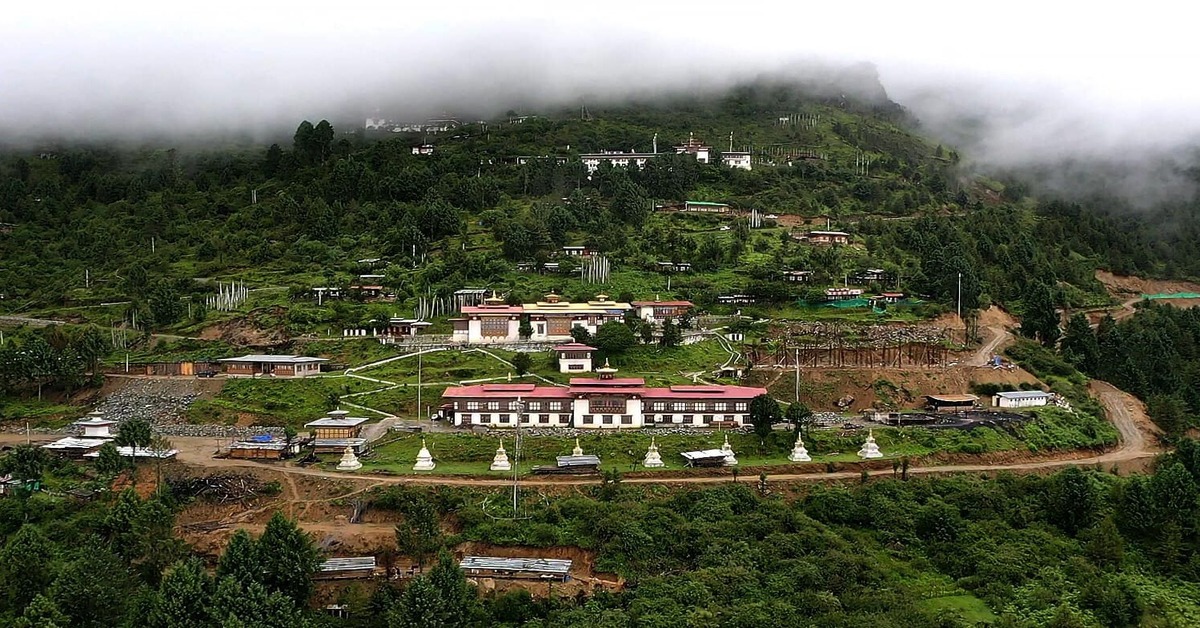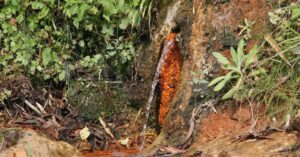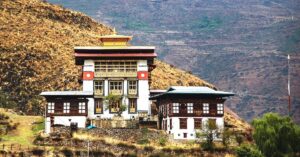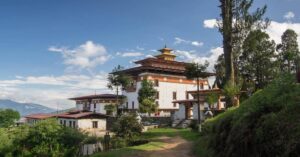Tharpaling Monastery is one of the eight sacred lings of Kunkhyen Longchen Rabjam (Longchenpa). It is the first Ling founded by Longchenpa in 1352. The monastic complex is located on the face of a hillock in Samling village in Bumthang Dzongkhag, at 4100 meters, overlooking the Chumey Valley. Guru Rinpoche blessed the sacred site in 746 AD.
It is said that Longchenpa liberated many devotees following his teachings, and the place was named Tharpaling, meaning “the place of liberation.” Tharpaling Goemba is also a sacred pilgrimage site, popular for the “Great Cannon of Tharpaling.” The festival of Tharpaling Monastery is Tharpaling Thongdrol.
Longchenpa is known for establishing the eight Lings in Bhutan. They are Babron Tharpaling, Shingkhar Dechenling, and Tang Ugyencholing in Bumthang, Kunzangling in Lhuntse, Khothang Pemaling/Rinchenling, Menlok Kunzangling, and Nyenlong Drechagling in Wangdue Phodrang, and Samtenling in Paro.
How to Reach Tharpaling Monastery
Tharpaling Lhakhang is 40 kilometers from Chamkhar town. It is on the same road as Mebartsho and is about a two-hour drive away. From Gyetsa village in Chumey Valley on the Trongsa-Jakar highway, a drive through the feeder road up to the monastery will take about half an hour. However, the road becomes impassable during the monsoon, so hiking to the monastery is the only option.
Tharpaling Monastery Hike
The hike starts from Gyetsa village, traverses through Lamey Gonpa in Choekhor, and crosses a pass above the Choedrak Monastery, taking about three hours. If it rains, the uneven trail gets muddy. The track consists of severe ascents and gradients. After an hour, the walk becomes more pleasurable due to the stunning view of the Chamkhar Valley.
The hike can be completed by returning via the ancient route of Bumthang and Trongsa, which offers a view of the stunning Jakar Dzong.
Sacred Relics to See at Tharpaling Monastery
- The Great Cannon of Tharpaling;
- Longchen Zhugthri, where Longchenpa composed and wrote half of Longchen Dzod Dun;
- Statues of Samantabhadra, Guru Rinpoche, and Longchenpa;
- Giant Thongdrol of Jowo Jampa and Kunkhyen Longchen Rabjam;
- Paintings of Gyalwa Lorepa and Tsangpa Gyare;
- Statues of Trisong Detsen and Jigme Lingpa;
- Paintings of the Paradise of Kunkhyen Longchenpa and Zhabdrung Ngawang.
- Paintings of the Paradise of Amitabha and Guru Dewa, a secret manifestation of Guru Rinpoche.
Also Read: Guru Rinpoche in Bhutan: His Visits to Bhutan and Sacred Sites
Historical Significance of Tharpaling Monastery
The history of Tharpaling Monastery states that in 746, after flying from Paro Taktsang on a tigress, Guru Rinpoche meditated on the holy place of Tharpaling. His arrival is evidenced by his footprints and the footprints of a tigress on a rock there. He has also extracted a Drupchhu there.
Also Read: Drupchhu or Holy Spring Waters in Bhutan: Beliefs and Benefits
Gyalwa Lorepa initially founded a Drukpa Kagyu monastery in the 12th century. Later, in 1352, Kuenkhen Longchen Rabjampa visited the place and converted it into a Nyingma monastery. Legend has it that Longchenpa gave the teachings of Yodsel Dorji Nyingpo. During his teachings, many devotees were enlightened and liberated. Consequently, the area was named Tharpaling, or the “Land of Liberation.” Inside Tharpaling Monastery, Longchenpa’s statue is depicted with his eyes raised to the sky, symbolizing him watching his enlightened disciples.
During the 15th century, Terton Pema Lingpa, a reincarnation of Longchenpa, discovered a Guru Statue, among other treasures from the sacred Tharpaling.
The monastery eventually fell into disrepair, and its importance was lost for centuries. However, at the start of the 20th century, the great saint Togden Shakya Shiri and the first king, Ugyen Wangchuck, rebuilt the monastery and established a retreat center with 13 practitioners. Later, the second king, Jigme Wangchuck, also maintained the site’s sanctity and completed significant renovations.
After that, a Buddhist scholar, Kuentop, transformed the center into a monastic establishment and underwent more renovations, establishing a significant monastic body for Buddhism’s Kagyu and Nyingma branches.
Description of Tharpaling Monastery
Tharpaling Monastery was built in 1352 at the sacred site blessed by Guru Rinpoche to propagate the teachings of Buddha. Today, it consists of a Dratsang (Monastic school) and Nyingma School’s Shedra (Monastic College).
The Eight Chortens are located directly beneath the monastery complex. They were constructed in 2001 to honor the Buddha’s life events.
Above the Chortens is the original small Tharpaling Lhakhang that houses the paintings of Lorepa and Tsangpa Gyare. The Tharpaling main building houses two temples. The Tshogkhang temple on the ground floor houses the main statues of Longchen Rabjam, Trisong Detsen, Guru Rinpoche, and Jigme Lingpa.
The small temple on the top floor contains exquisite paintings of Paradises Longchen Rabjam and Zhabdrung Ngawang Namgyal. It was restored during the reign of the First King of Bhutan, Ugyen Wangchuck. The first king is said to have resided in a little shrine next to the ancient temple, where he occasionally meditated in the Lhakhang.
A monastery school called Jangchub Choeling Shedra was established in 1985. This monastery houses more than 100 monks. The school’s assembly hall features beautiful murals of the Neten Chudrug (Sixteen Arhats) and the ancestry of Jigme Lingpa and Longchen Rabjam.
Here, you can also find the seat of Longchenpa, known as the Longchen Zhugthri. Longchen Rabjam has composed and written almost half of Longchen Dzod Dun sitting on this stone seat. Now, a statue of Longchenpa is installed inside a glasshouse on the Longchen Zhugthri.
Great Cannon of Tharpaling
The “Great Cannon of Tharpaling” is a huge, seven-foot phallus carved from stone and cement. This unique symbol serves a protective purpose, warding off evil spirits and maintaining the sanctity of the monastery.
The history of the Tharpaling Cannon is odd but fascinating. According to legend, many monks of Tharpaling gave up their monkhood due to the nearby village, which resembled a female organ. Thus, the number of monks in the monastery declined. The great cannon phallus was then erected, pointing toward that village to ward off evil spirits and preserve the sanctity of the monastery. It is said that the issue has subsided since the erection of the “great cannon of Tharpaling“.
Guru Lhakhang in Gelephu
Dungkor Lhakhang, or the Guru Lhakhang in Gelephu, is a winter residence of the monks of Tharpapling monastery. The monastic body of Tharpaling moves there in the winter season. Dungkor Lhakhang was built by His Majesty the 3rd King, Jigme Dorji Wangchuck, in 1969.
At the request of Bero Khentse Rinpoche of Pelpung, Home Minister Tamzhing Jagar granted the Lhakhang to serve as the winter residence of the monk body of Tharpaling. Rinpoche constructed hostels and repaired many precious wall paintings.
In 1989, the district governor of Wangdue Phodrang built a statue of Guru Padmasambhava and his two dakini consorts. Since then, the Lhakhang has been known as Guru Lhakhang.
Tharpaling Thongdrol Festival
The Tharpaling Monastery’s annual festival is Tharpaling Thongdrol. It is a one-day festival observed on the 15th day of the first month of the Bhutanese calendar. The festival is preceded by the Moelam Chenmo, which the monks of the Tharpaling monastery perform for ten days. The giant Thongdrol of Jowo Jampa and Kunkhyen Longchen Rabjam are displayed during the festival. However, no mask dances are performed during the entire festival.
Best Time to Visit Tharpaling Monastery
The best time to visit Tharpaling Goemba is during the Tharpaling Thongdrol festival in spring (March to May). The weather is pleasant, and the valleys are in full bloom with colorful flowers. Another good time is autumn (September to November), when clear skies and crisp air make hiking and sightseeing perfect. You can visit the major pilgrimage sites of Bumthang with the Bhutan Pilgrimage Package.
Places to Explore in Bumthang
Bumthang Dzongkhag is rich in culture and steeped in legends. Here are a few pilgrimage sites near Tharpaling Monastery:
Choedrak Monastery: Choedrak Monastery, a Buddhist monastery in Bhutan, is situated at 3,800 meters, overlooking the Chumey Valley.
Kurjey Lhakhang: One of Bhutan’s most sacred temples, believed to house a body print of Guru Rinpoche.
Jambay Lhakhang: One of the oldest temples in Bhutan, dating back to the 7th century, and famous for its annual festivals.
Mebar Tsho: Mebar Tsho is a sacred lake in Bhutan, renowned as the site where Terton Pema Lingpa discovered hidden treasures of Guru Rinpoche in 1475.
Jakar Dzong: Known as the “Castle of the White Bird”, this impressive fortress overlooks the town of Jakar and offers stunning views of the valley.
Tamzhing Lhakhang: The temple was founded in 1501 and is renowned for its ancient Buddhist art and relics.
Enjoyed reading this blog?




